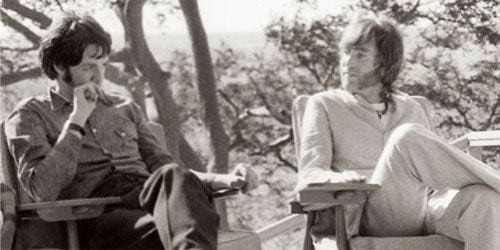
Composing Outside the Beatles: Lennon and McCartney 1967-1972 opens with John Lennon and Paul McCartney’s changing relationship following the 1966 release of Sgt. Pepper’s Lonely Hearts Club Band and continues through the release of their respective first few solo albums. At the starting point of the documentary, the two were drifting apart creatively as well as personally, and by the time Abbey Road was released, McCartney’s first solo album, McCartney was two weeks away from also being released.
The documentary combines a good deal of archival footage, videos, and song snippets; along with talking head interviews with Lennon and McCartney biographers, historians, critics, and former band members. The interviewers include Johnny Rogan, Chris Ingram, Anthony DeCurtis, and Robert Christgau, among others. Their contributions add a layer of real music criticism that is often sorely lacking in music documentaries.
With the glut of material released about The Beatles, it’s rare to find something that isn’t a blatant attempt to cash in on such a devoted following. Composing Outside the Beatles is the rare rock documentary made for real rock fans. Its in-depth look into such a specific period clearly marks the intended audience as beyond the casual fan.
The documentary shifts between its two subjects in analyzing, and of course, comparing their respective output with ease. While Lennon released some of his most celebrated solo work in the few short years following the demise of The Beatles, McCartney did not fare as well critically. Lennon’s emphasis on releasing singles such as “Instant Karma” and “Give Peace a Chance” earned him both commercial and critical success immediately.
In addition, with the release of the Plastic One Band and Imagine, all within two short years, he was most assuredly continuing to put out very strong material, post-Beatles. Conversely, McCartney’s first solo album, McCartney was a lo-fi, seemingly less ambitious work that marked him as working below his talents. Ram, his follow-up did little to dispel those opinions, particularly when placed in direct comparison with Lennon’s Imagine.
If there is any drawback to the documentary, it is in its partiality to Lennon over McCartney. There is a sense that many of the interviewees view Lennon as the more creatively gifted and important of the two, but that may also be attributed to the amount of screen time given to certain critics. For instance, Johnny Rogan is a particularly verbose Lennon historian and his interviews tend toward negative criticism of McCartney in his analysis of Lennon’s accomplishments. While there are plenty of more even-handed assessments of their musical outputs in the documentary, there is a propensity to favor Lennon.
Much of what makes Composing Outside the Beatles as good as it is, is its use of actual music by its subjects. It’s almost shocking to hear original music instead of subpar covers or incidental music and its inclusion should not be underestimated. Clocking in at over two hours, the documentary takes its time in using songs to illustrate the points made by its participants. In addition, there is some very nice footage of both Lennon and McCartney working in the studio and the commentary by Klaus Voorman (on Lennon) and Denny Seiwell (on McCartney) add a great deal of insight into their respective states of mind at the time. Voorman is especially candid in his recollections of song origins and Lennon’s writing style.
Voorman and Seiwell are especially sharp when it comes to discussing the feud that developed between Lennon and McCartney. There is a rather pointed clip of Lennon almost joyously playing “How Do You Sleep?”, his cutting song about McCartney, in the studio. Conversely, Seiwell clearly has a deep respect for McCartney and his reminiscences of the free, unstructured time in the studio offer a first-hand glimpse into McCartney’s recording process.
The documentary also makes it a point to focus on the contributions of both Yoko Ono and Linda McCartney. There’s a real sense of trying to present their place in the creative process in a way that is not judgmental or angry, not the way they are usually presented. The differences between the two are striking.
Ono’s sway is acknowledged as very influential, especially as it relates to the avant garde performances of the music, but Voorman notes that her approach with the musicians in the studio could be brusque. Conversely, Seiwell recounts Linda McCartney’s reluctance to become musically involved, particularly as a performer in Wings, but because McCartney wanted her there, essentially as a support system, she became a part of the band.
Composing Outside the Beatles does a very nice job of shedding light on pivotal creative period for Lennon and McCartney. While there’s a slight preference for Lennon’s work evidenced by the critics interviewed, both are given a fair treatment in analyzing their work. Not only is the music given an appropriate amount of dissection, but there is a real emphasis on context that is frequently lacking in documenting such iconic figures. The thoughtful interviews and tons of archival footage make for essential viewing for die-hard Beatles fans while still being accessible enough for a more casual viewer.

![Call for Papers: All Things Reconsidered [MUSIC] May-August 2024](https://www.popmatters.com/wp-content/uploads/2024/04/all-things-reconsidered-call-music-may-2024-720x380.jpg)



